The best dehumidifiers in 2024
The best dehumidifiers for every space

The best dehumidifiers are essential if you have excess humidity in your home, will help to reduce condensation and prevent mold. This is especially the case during colder months when we can't open up our windows for long periods to allow ventilation. In addition, dehumidifiers can help to get rid of odors and reducing dust and airborne allergens.
But with so many types of dehumidifier on the market, it can often be tricky to know which one is right for your needs. Before buying, there are some things to consider first. For instance, what coverage do you need for your home? If you have a particularly large or humid room, you may benefit from a machine with a higher capacity and a pump, to make disposing of the water easier. Also, if you have several rooms that need a dehumidifier, it may be worth buying a smaller, more portable unit or on wheels.
Luckily, we've done all the hard work to find a dehumidifier for every need, based on our comprehensive online research.
So, whether you're after a model for your basement, or a compact size, here are the best dehumidifiers to suit every space and lifestyle.
The quick list
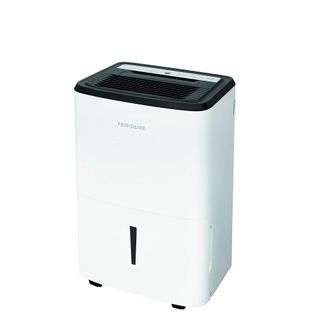
The Frigidaire FFAP5033W1 is a heavy-duty, 50-pin machine that was a solid performer. It comes with an active water pump for easy draining, or you can default to continuous draining. It also has a sleek design with an easy-to-use digital display, and the filter is easily accessible for removal and cleaning.
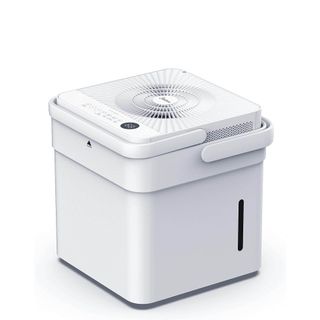
For those who space, this compact dehumidifier is a great option. The Midea 20 pint cube dehumidifier has a 20-pint capacity but gets the job done. Operated via an app, you can monitor it from your phone, view humidity levels and receive alerts when the bucket is full. It’s also easy to empty, thanks to the lower half that turns into a bucket and handle.
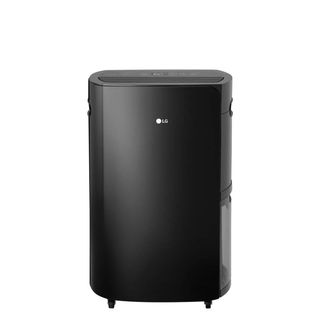
If you want a suitable machine for drying out midsize spaces, this LG PuriCare UD501KOG5 is ideal. It comes with a clear water bucket with a large handle, practical LED display, and has low-profile, attractive design. It has also received consistently high ratings from users.

If you have smaller spaces, this 22 pint machine will suit your needs. The Frigidaire FFAD2233W1 is quick, efficient, and performed well in all our tests. It comes with an easily accessible filter, cord-storage hooks and is portable on wheels — making it easy to move from room to room if needed.

If you’re after longevity, you’ll need the best warranty. The Honeywell TP50AWKN is covered under a 5-year warranty— which is one of longest available. In our tests, it gave a strong performance, and was energy efficient. The only downside is that the small tank requires frequent emptying, however, you’re getting value for money.

With smart connectivity, this dehumidifier from Frigidaire will fit into any smart home regime. You can operate it remotely via the app, set the target humidity and receive notifications when the bucket is full. And with a 50 pint capacity, it can hold plenty. Voice control is possible too via Amazon Alexa and Google Assistant.
The best dehumidifiers you can buy today
Why you can trust Tom's Guide
The best dehumidifiers you can buy
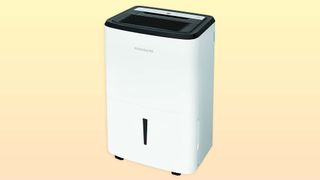
1. Frigidaire FFAP5033W1
Specifications
Reasons to buy
Reasons to avoid
The Frigidaire FFAP5033W1 is the best dehumidifier overall, based on reviews of its nearly identical predecessor, the Frigidaire FFAP7033T1.
It's one of the few devices on our list with an active pump, meaning you can send water to an elevated sink or out a window if you don't have a floor drain and don't want to go through the hassle of removing and emptying the bucket.
What bumped the Frigidaire FFAP5033W1 above the other devices we considered is its design. It's sleek and has an attractive digital display, making it easy to see indicator lights and settings.
There are hooks for wrapping up the power cord when the machine sits right next to an outlet or when you want to store it away, and the filter is easily accessible for removal and cleaning. While the device does come on casters for easy rolling, it also has a heavy-duty top handle for carrying down stairs.
One of the few areas in which the older model, the Frigidaire FFAP7033T1, fells short was in the initial pump setup. Testers and device owners reported that removing the plug from the pump socket was tricky, and that in some cases the plug simply broke off.
This flaw isn't unique to Frigidaire, but it is something to prepare for if you're purchasing this model for the convenience of having a pump. We'll keep an eye out to see if the FFAP5033W1 suffers from the same problem.
While the pump option does come at a premium, it's a nice feature to have. Of course, you can also default to continuous draining (if you have a floor drain) or to simply dumping out the bucket manually if you'd prefer.
In the switch from the FFAP7033T1 to the FFAP5033W1, Frigidaire increased the tank capacity from 13.1 pints to 16.9 pints. If you live in a really damp space and run the machine continuously, that's a significant improvement, because water volume will fill up pretty fast, and the device will shut down until you empty the bucket. The GE APER50LZ, our runner-up, has a 15-pint capacity.
As with many of the older models that fell under the previous set of Department of Energy regulations (see below), the FFAP7033T1 is disappearing from store shelves, so you'll have an easier time finding the Frigidiare FFAP5033W1 or its pump-less sibling, the FFAD5033W1.
On Amazon, customers liked the ease of setup, praising the simple controls and instructions. However, there are a few reports of ice buildup, and issues with warranty. They also differ on noise, and ease of emptying.
Best budget

2. Midea 20 pint cube dehumidifier
Our expert review:
Specifications
Reasons to buy
Reasons to avoid
We loved testing the Midea 20 smart dehumidifier. Once connected to its app, you can monitor it from your phone, including viewing the humidity levels and receiving alerts when the bucket is full. You can change the settings remotely too, adjusting the speed of the fan with three levels to choose from.
Voice control is available via Alexa or Google Assistant, although two-factor authentication is missing. It stands out for storage though, as this dehumidifier can be ‘nested’ into itself, taking up half of the space.
In terms of performance, it gets the job done and proved to be a useful asset for us when dealing with a flooded basement. It’s also incredibly easy to empty, thanks to the lower half turning into a bucket and handle.
Despite the name, it can hold about 24 pints, although this is still relatively small compared to others on our list. Ultimately, this dehumidifier has a very user-friendly design which couldn't be more compact to store.
Amazon reviews mentioned good performance and ease of setup. For instance, it's easy to connect to WiFi, runs well and does a good job. However, there are mixed opinions on ease of cleaning, noise, and appearance.
Read our full Midea 20 pint cube dehumidifier review.
Best for basement
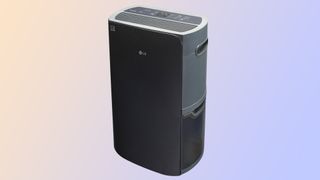
3. LG PuriCare UD501KOG5
Specifications
Reasons to buy
Reasons to avoid
The LG PuriCare UD501KOG5 is a medium-capacity, 50-pint dehumidifier good at drying out midsized spaces. It has an attractive design, a large digital display and a clear water bucket with a large handle. That makes it easy to see when the tank needs to be emptied, and the handle makes it easy to carry the tank to a drain or sink.
With Energy Star Certification, this is one of the most efficient dehumidifiers on the market. It also comes on four wheels, making it portable between rooms despite its larger dimensions.
The LG PuriCare UD501KOG5 has lots of positive user reviews on the Home Depot and Sam's Club websites. We'll keep an eye on real-world tests and update here accordingly.
Customers on Amazon have stated they like the humidity level, pump and appearance of the dehumidifier. It removes moisture from the air quickly, and has the ability to set your desired humidity level. They also like the appearance, although, opinions are mixed on quality and noise.
Best for bedroom

4. Frigidaire FFAD2233W1
Specifications
Reasons to buy
Reasons to avoid
The 22-pint Frigidaire FFAD2233W1, which replaces the 30-pint Frigidaire FFAD3033R1, is a great choice for laundry rooms, apartments and other small spaces. It's portable and its four wheels make it easy to move from room to room if needed.
The older machine, the FFAD3033R1, did well in real-world tests for water removal, reaching humidity levels that were 28% below where the tests started). It also did well on humidistat accuracy and cool-room performance.
The Frigidaire FFAD2233W1 also has user-friendly design features similar to those of its larger cousin, the FFAP5033W1, including an easily accessible filter and cord-storage hooks.
The Frigidaire FFAD2233W1 is Energy Star-certified. User reviews posted on the Amazon, Home Depot and Walmart sites were overwhelmingly positive. Particularly, about the ease of setup, simple controls and it's easy to understand.
Best warranty

5. Honeywell TP50AWKN
Specifications
Reasons to buy
Reasons to avoid
The Honeywell TP50AWKN, which replaces the virtually identical Honeywell TP50WK but adds Wi-Fi connectivity, is well regarded by professionals and customers alike.
If something does go wrong with the TP50AWKN, you're covered under Honeywell's five-year warranty. Most of the dehumidifiers we considered come with one-year or two-year warranties, so this extended policy ensures that your investment is protected.
One downside: The Honeywell TP50AWKN's water bucket holds just 7 pints (three-quarters of a gallon), a small fraction of what the machine can condense in a day. If you don't have the option to continuously drain, you'll find yourself emptying the water bucket more frequently with the Honeywell TP50AWKN or going without dehumidification once the tank reaches capacity.
Customers posted on Amazon liked the ease of use, and say it's easy to set up. However, opinions are mixed on durability, moisture sensor, performance, and noise.
Best smart controls
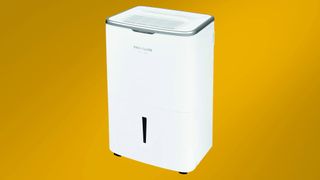
6. Frigidaire FGAC5044W1
Specifications
Reasons to buy
Reasons to avoid
You probably don't need a Wi-Fi-enabled dehumidifier, but if smart-home devices are your jam, then the 50-pint Frigidaire FGAC5044W1 may deliver on what you're looking for.
You'll receive push notifications when the water bucket is full, and you'll be able to remotely control the fan speed, target humidity and power. You can also set up voice controls for the Frigidaire FGAC5044W1 with Amazon Alexa and Google Assistant.
All these smart features can be especially handy if you're out of town or you're monitoring a dehumidifier in a rental property. However, many online purchasers of the unit reported trouble setting up the app, which gets mostly negative reviews on both Google Play and the App Store. Here's hoping Frigidaire gets that sorted out.
This dehumidifier is fairly similar to our top pick, the Frigidaire FFAP5033W1, but swaps Wi-Fi for a powered water pump. A drain hose comes with the unit to let the tank drain passively, or you can dump out the 2-gallon bucket by hand.
There's also a washable dust filter and an ionizer to eliminate airborne particles.. A light at the top of the front face changes color to let you know system status.
Hundreds of Amazon, Wayfair and Walmart customer reviewers liked the Frigidaire FGAC5044W1 a lot (even if many of them didn't like its mobile app), rating the unit at 4.4 out of 5 stars on average.
Amazon reviews stated customers liked the performance, ease of use, and humidity of the dehumidifier. They also mention it does a great job of pulling humidity out of the air and that the wheels work well on cement floors. However, opinions are mixed on noise, value, and capacity.
(Note: This replaces an older model, the Frigidaire FGAC7044U1, which has been discontinued.)
Best for small spaces

7. HomeLabs 22 Pint Dehumidifier
Specifications
Reasons to buy
Reasons to avoid
The HomeLabs 22 Pint Dehumidifier, which replaces the 30-pint model, has a 1,400 Sq Ft coverage. This makes it a great choice for small spaces including apartments, basements and other spaces. It's sleek and minimal, which is ideal to place in a room without taking up a lot of space.
This model did well in our real-world tests for managing humidity levels in the bathroom, laundry room, and storage space with the doors open. It did particularly well in a basement bathroom, measuring approximately 100 square feet.
When the temperature reached up to 79% humidity, it had taken about an hour for the levels to reach the target of 35%. The unit used about 235 watts while running, and used about .20 kWh. However, it seemed to struggle with handling humidity in larger spaces or exceeding 900 square feet, with a longer run time of four hours. In any case, our tests results were far more accurate in smaller spaces, and it works well in less time.
Generally, the Homelabs 22 dehumidifier is easy to set up and use, with a quiet operation, around 55 decibels. Since it has a smaller tank, it does tend to fill up quickly if the room is very humid. Although, this also means that you’ll need to empty it more frequently.
Read the full HomeLabs 22 Pint Dehumidifier review.
Comparison chart
| Row 0 - Cell 0 | Floor area (Square Foot coverage) | List price | Capacity (pints) | Drainage type | Digital controls |
| Frigidaire FFAP5033W1 | 4,500 Sq. Ft | $369 | 50 | Pump | Yes |
| Midea 20 pint cube dehumidifier | 1,500 Sq. Ft | $178 | 20 | Passive | Yes |
| LG PuriCare UD501KOG5 | 2,000 Sq Ft | $300 | 50 (30 under new standards) | Passive | Yes |
| Frigidaire FFAD2233W1 | 1,500 Sq.Ft | $219 | 22 | Passive | Yes |
| Honeywell TP50AWKN | 4,000 Sq. Ft | $419 | 30 | Passive | Yes |
| Frigidaire FGAC5044W1 | 4,500 Sq Ft. | $379 | 50 | Passive | Yes |
| HomeLabs 22 | 1,400 Sq Ft | $219 | 22 | Passive | Yes |
How we chose




To determine the best dehumidifiers on the market, we researched the top picks that are currently on the market, as well as top-selling and highly reviewed machines on Amazon, Best Buy and The Home Depot.
While we aim to extensively test all of the best dehumidifiers on our list, we did have hands-on testing with the HomeLabs 22 Pint dehumidifier and Midea Cube 20 Pint dehumidifier so far.
The key things that we look for include performance quality, features, price, efficiency and ease of use. In addition, we use a smart air quality monitor to show how efficient it works in a stable environment (our tester's damp basement), and use a noise meter to test the sound levels.
How to buy the best dehumidifier
There are a huge range of dehumidifiers on the market. Before choosing your favorite, here are a few factors you should consider:
Type
There are different types of dehumidifiers on the market. The most common type is a condensing dehumidifier, which pulls the absorbed air over refrigerated coils, which cools it enough the condense and separate the moisture.
Other types include desiccant dehumidifiers, which will use a water-absorbing material, and thermoelectric dehumidifiers, which operate with charged plates. Generally speaking, neither of these latter two types are as effective as condenser models, which is why we only recommend this type in our list.
Capacity
Dehumidifiers generally come in three sizes: large (45-50-pint capacity), medium (30-pint capacity) and small (20-22-pint capacity).
Under the old regulations, these sizes were 70, 50 and 30 pints, respectively, and you'll see such numbers with three older models above.
Noise level
If you’ll be placing a dehumidifier in a quiet room, such as a bedroom or home office, where you need to fall asleep or concentrate without being disturbed, consider the noise level of the dehumidifier before you buy. Aim for a dehumidifier with a decibel level of around 50 decibels or below, anything above this level will be louder.
Features to look out for
Pint capacity — The capacity in pints relates to how much moisture the dehumidifier claims to absorb per day. The bigger the capacity, the larger and damper space it can handle.
Bucket size — Pint capacity shouldn’t be confused with bucket size however. This specification indicates how much the internal bucket can actually hold before it will need to be emptied. The larger the bucket, the less often you will need to empty it.
Drainage type — On this list you will find passive and pump drainage types. Passive types let you passively drain the water through a hose, or alternatively you can manually carry and empty the bucket yourself. Whereas pump drainage types will automatically pump the water out. Pumps are preferred as the water doesn’t need to rely on gravity alone to drain, so you can direct the hose into a sink or out of the window. However, these models do cost more than without.
Energy Star Certification — It’s always useful to look out for Energy Star Certification as this guarantees savings in terms of energy and money.
Humidity sensor — With a humidity sensor, your dehumidifier will detect relevant changes in the atmosphere and can automatically switch on and, in some cases, set its power accordingly. Those without a sensor will just be manually controlled.
Frost sensor — A frost sensor will detect the formation of ice on the condenser coils. The dehumidifier will then shut off the compressor to give the ice a chance to melt. If it continues to run with frost on the coils, this can damage the parts and make the appliance work much harder to absorb any moisture.
Auto restart — If the dehumidifier suddenly loses power, auto restart means it will automatically switch back on to its previous settings once power is restored.
Number of speeds — This relates to how many speeds the fan has on the dehumidifier. The more speeds there are, the better as it gives you greater control and means excess energy isn’t wasted.
If you're still unsure, check out these things you should know before buying a dehumidifier and 5 reasons your home needs a dehumidifier this summer. As long as your avoid these 7 common dehumidifier mistakes.
Where is the best place to put a dehumidifier?
Ideally, a dehumidifier should be placed in the centre of a room to work efficiently. This allows the air to circulate properly around the unit.
Generally, a dehumidifier can dry out a room between 24 and 72 hours. But this depends on whether the room is large or has high humidity levels, which would take up to weeks to dry out.
For more top tips, check out our guide for where's the best place to put a dehumidifier.
How to clean a dehumidifier
When you consider that bacteria and mold is being sucked into your humidifier, it’s no wonder that it needs an occasional clean. Knowing how to clean a dehumidifier isn’t as difficult as you might think, simply follow these steps if none are given in your manual:
1. Unplug the humidifier from the wall. You don’t want to risk an electric shock!
2. Remove the water reservoir bucket and tip out any residual water. Clean this with warm soapy water and a microfiber cloth.
3. While that’s drying, wash the filters. The filters collect any impurities so it’s essential that these get an occasional clean. You should have a main filter and potentially a much smaller bucket filter. If you’re not sure where to find these you can refer to your manual. Both need to be washed in warm soapy water, rinsed and then left to dry.
4. If you notice a lot of dust inside your machine, you can also use a vacuum cleaner with a brush attachment to pick up any remaining fluff.
5. Lastly, give the outside a once over with a microfiber cloth for finishing touches.
Do dehumidifiers help to cool the air?
Dehumidifiers remove moisture from the air and can make a room feel less humid. However, they don’t cool the temperature of the air — although the effect of the reduction in the moisture level can make it feel as though it’s cooler. In fact, a dehumidifier will produce heat while it’s working, which may slightly increase the room temperature.
Is it better to oversize your dehumidifier?
In some cases, there can be advantages for buying a larger dehumidifier. Experts suggest to run it on a lower setting, and this will being down your electricity usage and energy bills.
What's more, if a dehumidifier is run on a lower setting, this also means a lower noise level, which is ideal for bedrooms.
Sign up to get the BEST of Tom's Guide direct to your inbox.
Get instant access to breaking news, the hottest reviews, great deals and helpful tips.

As the Homes Content Editor, Cynthia Lawrence covers all things homes, interior decorating, and garden-related. She has a wealth of editorial experience testing the latest, ‘must-have’ home appliances, writing buying guides and the handy ‘how to’ features.
Her work has been published in various titles including, T3, Top Ten Reviews, Ideal Home, Real Homes, Livingetc. and House Beautiful, amongst many.
With a rather unhealthy obsession for all things homes and interiors, she also has an interior design blog for style inspiration and savvy storage solutions (get rid of that clutter!). When she’s not testing cool products, she’ll be searching online for more decor ideas to spruce up her family home or looking for a great bargain!